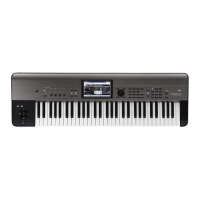Sequencer mode
180
Create Control Data
Create Control Data is available on all of the tabs of the
Track Edit page.
This command creates the specified type of data (control
change, aftertouch, pitch bend, or tempo) in the selected
region of a track.
1. In Track Select, select the MIDI track on which you
wish to perform the Create Control Data command.
If you wish to modify tempo data, select Master Track as the
track. In this case, the step 4 item Kind will be set to Tempo.
2. Select “Create Ctrl Data” to open the dialog box.
3. Specify the range into which the control data will be
inserted.
In From Measure and To End of Measure, specify the
measures, and in Beat.Tick, specify the beat and clock. (By
default, From Measure and To End of Measure will be set to
the range you specified in the Track Edit page.)
4. Set “Kind” to the type of musical data (event) that you
wish to create.
Control change: Control change data will be inserted. In this
case, use # to specify the control change number.
After Touch: Aftertouch data will be inserted.
Pitch Bend: Pitch bend data will be inserted.
Tempo: Tempo data will be inserted (if you’ve selected the
master track).
5. In Start Value, select the starting value of the control
data. In End Value, select the ending value of the con-
trol data.
By default, the Start Value will be set to the value of the
existing data at the start location. If you wish to create
control data that changes smoothly from the starting
location, you can leave the Start Value unchanged, and set
only the End Value.
When you execute Create Control Data, a large amount of
sequencer memory will be consumed. For this reason it
may not be possible to execute this command if there is a
limited amount of memory remaining. In such cases, first
use
Quantize
to quantize the data and remove unnecessary
control data. Alternatively, you could quantize the data
that was inserted by the Create Control Data command.
Example Move measures 3-4 of track 1 to measures 3-4 of track 2.
Track 1
Before Move
2 (Tr1)1 (Tr1) 5 (Tr1)4 (Tr1)3 (Tr1)
Track 2
2 (Tr2)1 (Tr2) 5 (Tr2)4 (Tr2)3 (Tr2)
After Move
Mode: Stay
Mode: Shift
Track 1
Overlap: Merge
2 (Tr1)1 (Tr1) 5 (Tr1)
Track 2
2 (Tr2)1 (Tr2) 5 (Tr2)4 (Tr1+2)3 (Tr1+2)
No data No data
After Move
Track 1
Overlap: Overwrite
2 (Tr1)1 (Tr1) 5 (Tr1)
Track 2
2 (Tr2)1 (Tr2) 5 (Tr2)4 (Tr1)3 (Tr1)
No data No data
After Move
Track 1
Track 2
Track 1
Before Move
Track 2
2 (Tr1)1 (Tr1) 3 (Tr1)
2 (Tr2)1 (Tr2) 5 (Tr2)4 (Tr1) 7 (Tr2)6 (Tr2)3 (Tr1)
No data No data
2 (Tr1)1 (Tr1) 5 (Tr1)4 (Tr1)3 (Tr1)
2 (Tr2)1 (Tr2) 5 (Tr2)4 (Tr2)3 (Tr2)
0
3:00 3:24 3:48 3:72 4:00 4:24 4:48
127
100
Location
After touch
Previous data
Start location End location
End Value
Start Value
default value
Example: The controller is aftertouch. Starting location is 3:48, ending location is
4:24, and end value is set to 100. This will cause the aftertouch value to begin
changing from 3:48, and reach a value of 100 at 4:24.

